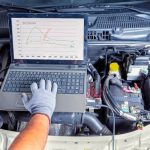After you retrieve the trouble codes from your vehicle’s on-board computer, you can now check the car sensors. Always refer to your service manual for specifications on your make and model vehicle.
The first trouble code to check is the throttle position sensor (TPS). The TPS is located either on the side of the carburetor or the side of the fuel injected models. It is attached to the throttle body. Visually inspect the sensor for worn insulation on the wires and a loose or cracked connection. Disconnect the sensor.
With the digital volt ohm meter or DVOM in the 20K ohm position, connect the positive DVOM lead to the sensor’s center terminal. Connect the negative DVOM lead to one of the other sensors’ terminals. Slowly move the throttle lever until it is at the wide-open position.
Depending upon which terminal you connected the negative DVOM lead to, the DVOM reading should either increase or decrease steadily. Release the throttle lever slowly. If the DVOM reading is not gradual and steady, but moves instead at an irregular pace, the sensor is defective and should be replaced. Re-connect the sensor.
Clear the trouble codes from the ECM memory by disconnecting the negative battery cable for at least ten seconds.
Your next trouble code indicates a mass air flow (MAF). The MAF sensor is located between the air cleaner and engine throttle body. To test, start the engine. Take a screwdriver handle and tap the MAF lightly several times on the plugin side. DO NOT STRIKE THE SENSOR WITH FORCE, IT MAY CRACK.
If the engine staggers, misfires, or stops running, the sensor is defective and should be replaced. Clear the trouble codes from the ECM memory by disconnecting the negative battery cable for at least ten seconds.
Start the oxygen sensor performing test by removing the sensor from the vehicle. The oxygen sensor is located either in the exhaust manifold or the exhaust pipe. Visually inspect the sensor for worn insulation on the wire and a loose connection.
Start the engine and let it run for about five minutes, then turn the engine off. Disconnect the sensor. Secure the sensor connector away from the exhaust manifold; tape the connector to the fender well, if possible.
Turn the digital vote ohm meter to the millivolt setting, connect the positive DVOM lead into the sensor connector terminal, and ground the negative DVOM lead to an unpainted ground. Restart the engine. Observe the DVOM reading. It should fluctuate between 100 and 1,000 mv (0.1 and 1.0 volts).
If the voltage does not fluctuate in the pattern indicated above, the oxygen sensor is faulty and should be replaced. Re-connect the sensor. Clear the trouble codes from the ECM memory by disconnecting the negative battery cable for at least ten seconds. Do not set the digital volt ohm meter on the ohm meter setting to do so will damage the oxygen sensor.
The next trouble code indicates manifold air pressure (MAP) sensor. The MAP sensor is usually located on the firewall or the fender well. Visually inspect the vacuum hose and sensor connector for deterioration or loose connections then disconnect the sensor. Connect a jumper wire from terminal A on the MAP sensor to terminal A on the connector. Using a second jumper wire, connect the terminal in the same way.
Turn the ignition switch on. DO NOT START THE ENGINE.
With the digital volt ohm meter (DVOM) in the 20-volt DC setting, connect the positive DVOM lead to terminal B on the MAP sensor.
Ground the negative DVOM lead to an unpainted ground. Observe the reading; it should be between 4.5 and 5 volts. Start the engine, let it idle.
Keep the engine at idle and repeat the previous step. If it does not change from the ordinal ones, the sensor is faulty and should be replaced. Reconnect the sensor. Clear the trouble codes from the ECM memory by disconnecting the negative battery cable for at least ten seconds.
This is how to test some of the sensors on a vehicle. There are many more sensors on a car. There are other ways to test them depending on the make and model of the vehicle. When you get ready to retrieve trouble codes or test your sensors, always check the service manual for specifications and how to test your sensors.
Another way to test sensors or see their reported data is with a scanner which plugs to car’s obd port.






It’s good
Good explanation
I have learned a lot from what you just said it seems easy but me being a woman and a senior it’s hard to trust anyone but I will bring this up tomorrow with my mechanic thank you